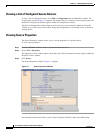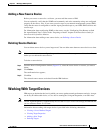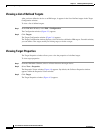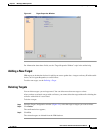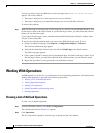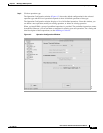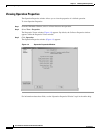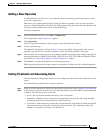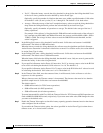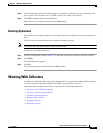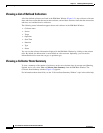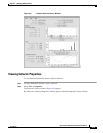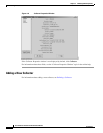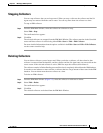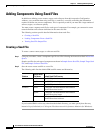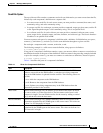
4-10
User Guide for Internetwork Performance Monitor
OL-11291-01
Chapter 4 Modifying IPM Components
Working With Operations
• X of Y—When the latency exceeds the rising threshold or drops below the falling threshold X out
of the last Y times, perform the action defined by Action Event Type.
Optionally, specify the number of violations that must occur within a specified number. Valid values
for both the x-value (X) and y-value (Y) are 1 through 16. The default is 5 for both values.
• Average—When the average of the last X completion latency values exceeds the rising threshold or
drops below the falling threshold, perform the action defined by Action Event Type.
Optionally, specify the number of operations to average. The default is the average of the last 5
latency operations.
For example, if the collector’s rising threshold is 5000 milliseconds and the results of the collector’s
last 3 attempts are 6000, 6000, and 5000 milliseconds, the average would be 6000 + 6000 + 5000 =
17000/3 > 5000. The average of these values exceeds the 5000-milliseconds threshold, and the
action is triggered.
Step 3 In the Rising field, enter a rising threshold, in milliseconds. Valid values are between 1 and 99999
milliseconds. The default is 5000 milliseconds.
When the latency exceeds the rising threshold, the collector uses the algorithm specified in Generate
Action Event to determine if a threshold violation has occurred. If a violation occurs, the action defined
in Action Event Type is taken.
Step 4 In the Falling field, enter a falling threshold, in milliseconds. Valid values are between 0 and 99999
milliseconds. The default value is 3000 milliseconds.
When the latency falls below the falling threshold, the threshold is reset. Only one event is generated for
the time the latency is above the rising threshold.
Step 5 If you specified a Generate Action Event of Consecutive, X of Y, or Average, enter a value in the X field
to be used in calculating the threshold. Valid values are 1 to 16. The default is 5.
If you specified a Generate Action Event of X of Y, enter a value in the Y field for the Y value to be used
in calculating the threshold. Valid values are 1 to 16. The default is 5.
Step 6 In the Timeout Value field, enter the amount of time, in milliseconds, for the collector to wait for a
response to its echo operation.
When a timeout occurs, the Timeout counter is incremented. The timeout value must be less than the
specified sample interval. Valid values are between 0 and 604800.
The default value is:
• 60000 milliseconds (for TCP Connect operations)
• 9000 milliseconds (for DNS operations)
• 5000 milliseconds (for all other operations)
To ensure interoperability with Cisco IOS, the Timeout Values for TCP Connect and DNS operations are
fixed at 60000 and 9000 milliseconds, respectively. If you enter some other value, IPM changes the value
you enter to the default value.
Step 7 Enable the Timeout Value option to check for latency reporting operation timeouts based on the timeout
value configured for the collector.
If you enable the Timeout Action option, the action (specified in Action Event Type) is taken when a
timeout occurs, or is cleared on this collector.



